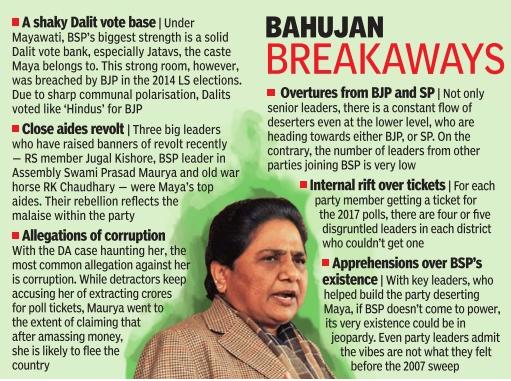Bahujan Samaj Party

This is a collection of articles archived for the excellence of their content. |
History
BAMCEF> DS4> BSP
Pankaj Shah, Feb 27, 2017: The Times of India The sprawling Gulab Bari (Garden of roses) housing the mausoleum of Nawab of Oudh Shuja-ud-Daula, has been one of the main tourist attractions in Faizabad. Centred in the middle of the city, the 18th century structure, however, has another history -it once happened to be one of the many crucibles in the discreet caste laboratory of Dalit leader Kanshi Ram, long before he went on to form the political behemoth called Bahujan Samaj Party .
“It was sometimes in mid1970s. Saheb (Kanshi Ram), who was still in his formative years as a Dalit leader used to call us to Gulab Bari to discuss issues concerning people of the lower caste and how they can be grouped socio-politically to overthrow the might of the existing political dispensation,“ recalled Ram Karan, former banker and associate of Kanshi Ram.
The Dalit amalgamation experiment of Kanshi Ram began on December 6, 1978 and he went on to form a semi-political entity, Backward and Minority Community Employee Federation (BAMCEF). The members of the group, comprising essentially the educated from the lower caste community were turned into a cadre before being sent into Dalit dominated hamlets. “We would meet people of lower castes and tell them about their constitutional rights,“ Ram Karan said.
Exactly three years later, on December 6, 1981, BAMCEF transformed into another organisation called Dalit Shoshit Samaj Sanghasrh Samiti (DS-4). The role of its members remained more or less the same until April 14, 1984 when Kanshi Ram eventually founded the BSP .
The party, however, made its presence felt first time in 1989 assembly elections when it won 13 seats.Though party floundered marginally in 1991, it rose significantly in 1993 when it won 67 seats while contesting in alliance with the Samajwadi Party . It was this year Kanshi Ram's caste lab bore fruit and his party won five out of 10 assembly seats in Faizabad. The five seats were actually in present day Ambedkarnagar which was carved out of Faizabad by then CM Mayawati on September 29, 1995.
2016: Key desertions hamper recovery
The Times of India, Jul 02 2016
Pankaj Shah When Mayawati's Bahujan Samaj Party drew a blank in the 2014 Lok Sabha elections, pollsters said a major factor responsible for her debacle was the desertion of her core Dalit vote bank. Two years later, Mayawati has come to face yet another challenge -rebellion from her key party leaders. That too at a time when her party is considered to be on a revival course with a good show in the local bodies and Rajya Sabha elections ahead of the UP assembly polls due in less than a year. While top BSP functionaries refuse to comment, insiders say that the recent rebellion by some of her top leaders -Jugal Kishore, Swami Prasad Maurya and now RK Chaudhary -is bound to send ripples of apprehensions within party cadres who have been silently working on the ground. After all, Maurya was leader of Opposition and still has his sway over pockets in UP . Political experts however insist it is premature to write off the BSP since Mayawati has a history of bouncing back from troubled political waters.
The BSP chief, experts point out, managed to send back a strong positive message to her cadres when her party-supported candidates did well in the 2015 panchayat polls. In June, BSP nominees garnered the highest number of votes in the UP Legislative Council and Rajya Sabha elections, further emboldening her comeback bid. “BSP is known as a factory for producing leaders,“ says Badri Narayan, political expert, professor of social sciences in JNU. “But they're leaders within the party .Once out, they become ordinary functionaries with nowhere to go.“
Observers maintain Maya's calculation of riding back to power rests on consolidating her Dalit vote bank, 21% of the state's population. Of this, roughly 56% are Jatavs, Mayawati's caste. It is this section, about 15% of UP's population, that gives BSP an edge over other parties. But that alone will not ensure a win. She also needs votes from other communities, including Muslims, Most Backward Castes (MBC), Brahmins and Thakurs.
In 2007, Mayawati successfully toyed with the social engineering formula by fielding Brahmin candidates alongside the Dalits.Sources say Mayawati is contemplating a new formula this time -a Dalit-Muslim combination with people from other castes and communities chipping in. In fact, Mayawati has repeatedly been playing the Muslim card -more so in the wake of a surging BJP .
Her calculations, however, got disturbed after the saffron ranks reportedly orchestrated desertion of Dalits from the BSP camp by bracketing them as `Hindu first' in 2014.As Mayawati attempts to consolidate her core vote, the recent rebellion could damage BSP's prospects. She has hit out at the deserters, saying the party's better off without them and hammers home her accusation that SP and BJP are hand in glove. Bluster or strategy? With Mayawati, it's not easy to tell. What is intriguing is that none of the three netas who quit has joined any party yet.